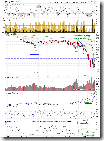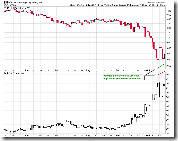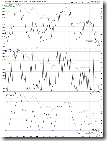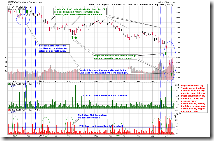0.0.2 SPY Short-term Trading Signals. Technically today is a Bullish Reversal Day, and the last Friday low was successfully tested. But a follow-through tomorrow is still needed.
On the following chart, SPX has a higher low while VIX has a new high, and this is a positive divergence. This is great and many professional traders are waiting for this signal to resume trading.
1.0.4 S&P 500 SPDRs (SPY 15 min). This chart shows the potential target and resistance should the rally continues.
2.4.3 Breadth Oversold/Overbought Watch. Note that if the market becomes rational again, all extremely oversold breadth signals on the following chart have to be corrected. This means the rally will very likely continue. Among those signals, the current levels of NYA50R and NYHILO indicate a mid-term bottom under the normal market condition.
1.0.5 Major Accumulation/Distribution Days. Previously I mentioned that Major Distribution Day means the market will rally for 22% within 60 days. A reader asked if past two Major Accumulation Day still count after getting a Major Distribution Day yesterday. The answer is yes. On the following chart, the Major Distribution Day between April and May did not affect the rally in May. On the other hand, I have a little bit concern to the first Major Accumulation Day in September, because it was manually made by market makers after an unexpected selling off ($700B bailout plan was rejected). Therefore it is better to have another Major Accumulation Day just to be safe. Concerning the forming of the market bottom, a research paper says that, the market is likely bottomed out if a Major Accumulation Day follows a Major Distribution Day. This is exactly what happened in the last week and this Monday, and so the market is very likely bottomed out. For your information, here is the excerpt of the article:
The historical record shows that 90% Downside Days do not usually occur as a single incident on the bottom day of an important market decline, but typically occur on a number of occasions throughout a major decline, often spread apart by as much as thirty trading days. For example, there were seven such days during the 1962 decline, six during 1970, fourteen during the 1973-74 bear market, two before the bottom in 1987, seven throughout the 1990 decline, and three before the lows of 1998. These 90% Downside Days are a key part of an eventual market bottom, since they show that prices are being deeply discounted, perhaps far beyond rational valuations, and that the desire to sell is being exhausted.
But, there is a second key ingredient to every major market bottom. It is essential to recognize that days of panic selling cannot, by themselves, produce a market reversal, any more than simply lowering the sale price on a house will suddenly produce an enthusiastic buyer. As the Law of Supply and Demand would emphasize, it takes strong Demand, not just a reduction in Supply, to cause prices to rise substantially. It does not matter how much prices are discounted; if investors are not attracted to buy, even at deeply depressed levels, sellers will eventually be forced to discount prices further still, until Demand is eventually rejuvenated. Thus, our 69-year record shows that declines containing two or more 90% Downside Days usually persist, on a trend basis, until investors eventually come rushing back in to snap up what they perceive to be the bargain of the decade and, in the process, produce a 90% Upside Day (in which Points Gained equal 90.0% or more of the sum of Points Gained plus Points Lost, and on which Upside Volume equals 90.0% or more of the sum of Upside plus Downside Volume). These two events – panic selling (one or more 90% Downside Days) and panic buying (a 90% Upside Day, or on rare occasions, two back-to-back 80% Upside Days) – produce very powerful probabilities that a major trend reversal has begun, and that the market’s Sweet Spot is ready to be savored.






2 Comments